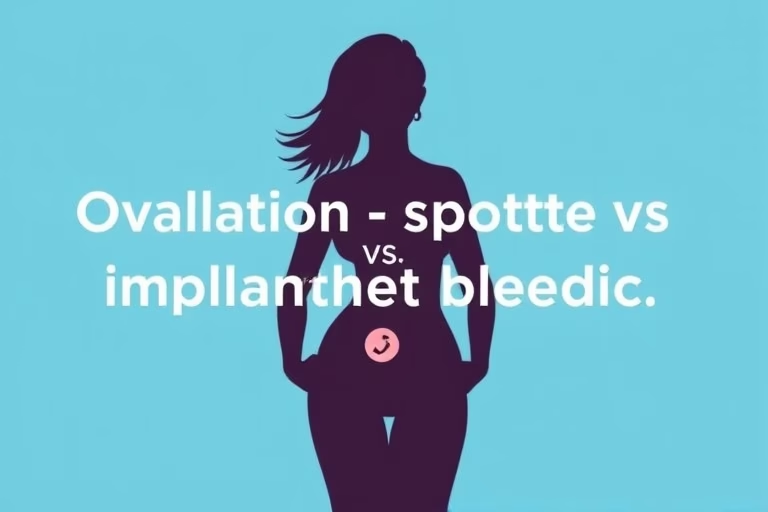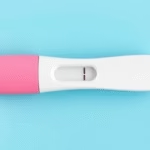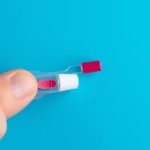Understanding Ovulation Spotting and Implantation Bleeding
In this blog post, we will be talking about ovulation spotting vs implantation bleeding, two terms often associated with women’s reproductive health. Both of these occurrences can be confusing for those trying to conceive or those simply monitoring their menstrual cycles. Ovulation spotting refers to light bleeding that occurs during the ovulation phase of a woman’s menstrual cycle. This happens when a mature egg is released from the ovary, and it can be accompanied by other symptoms such as mild cramping. On the other hand, implantation bleeding occurs when a fertilized egg attaches itself to the lining of the uterus, which typically happens about a week after conception. This bleeding is usually lighter and shorter in duration than a regular menstrual period. Understanding the differences between these two types of bleeding is crucial for those tracking their fertility cycles and hoping for pregnancy.
What is Ovulation Spotting?
Ovulation spotting is a light bleeding that some women experience during their ovulation phase. Typically, this happens around the middle of the menstrual cycle, often 10 to 14 days before the start of a woman’s next period. The spotting is generally light pink or brown in color and can last from a few hours to a couple of days. While not all women experience ovulation spotting, it can serve as an indicator that ovulation is taking place. This is especially useful for those trying to conceive, as understanding one’s ovulation window can increase the chances of pregnancy.
Many hormonal changes happen during ovulation, which might cause slight spotting. This results from estrogen levels fluctuating as the body prepares for either fertilization or menstruation. Ovulation spotting may also be accompanied by other symptoms like increased cervical mucus, breast tenderness, and mild abdominal pain known as mittelschmerz.
It is important to note that ovulation spotting is typically harmless. However, if there is significant pain, a heavy flow, or any other concerning symptoms, it is advisable to consult a healthcare professional. Knowing the signs of ovulation can empower women to better understand their bodies and reproductive health.
What is Implantation Bleeding?
Implantation bleeding occurs when a fertilized egg attaches itself to the endometrial lining in the uterus. This event usually happens between 6 to 12 days after conception. Implantation bleeding is generally lighter than menstrual bleeding, often presenting as pink or brown spots rather than bright red blood. The duration of this bleeding typically ranges from a few hours to a few days.
For women trying to conceive, recognizing implantation bleeding can provide early indications of pregnancy. Some may confuse this bleeding with an early period. However, the timing and nature of the bleeding can help differentiate between the two. Implantation bleeding tends to occur before a missed period and is often lighter and shorter in duration.
Other signs of early pregnancy can accompany implantation bleeding. These may include mild cramping, nausea, and fatigue. Understanding these symptoms can help women identify whether they are experiencing implantation bleeding rather than menstruation.
Differences Between Ovulation Spotting and Implantation Bleeding
Understanding the differences between ovulation spotting and implantation bleeding is essential. Ovulation spotting typically occurs midway through the menstrual cycle, while implantation bleeding happens a week or more after conception. The color, flow, and duration of the bleeding also differ significantly between the two.
Ovulation spotting may last a few hours or days and is often accompanied by other ovulation signs such as increased mucus. Implantation bleeding, on the other hand, is usually very light and happens more abruptly without many accompanying symptoms. It is important to note that while both types of spotting can be a normal part of a woman’s cycle, they indicate different physiological processes.
Additionally, understanding when these events occur in relation to the menstrual cycle can help women track their fertility more effectively. This information can assist in planning for pregnancy or simply gaining more knowledge about one’s body.
How to Recognize the Signs
Identifying the signs of ovulation spotting and implantation bleeding can be crucial for women trying to conceive. Keeping track of one’s menstrual cycle can make recognizing these signs easier. Many women find it helpful to use apps or journals to record their cycle lengths, symptoms, and any unusual occurrences.
Pay attention to the timing of any spotting. Since ovulation occurs roughly two weeks before the next expected period, spotting around that time may be related to ovulation. In contrast, if there’s light bleeding a week or so before your period, it may be implantation bleeding.
Observe the flow and color of the bleeding. Ovulation spotting is often light pink or brown, while implantation bleeding may be even lighter in color. Note the duration as well; ovulation spotting can last longer than the brief episode often seen with implantation bleeding.
Consult a healthcare provider if you experience any confusion or concerning symptoms. Other factors could influence spotting, and a professional can provide the necessary guidance. Keeping track of your reproductive health empowers you to make informed decisions.
When to Seek Medical Advice
Knowing when to seek medical advice is crucial for women who experience any type of unusual spotting. While ovulation spotting and implantation bleeding are typically normal, significant pain, an unusually heavy flow, or prolonged bleeding warrants consultation with a healthcare provider. These symptoms could signal issues like hormonal imbalances, fibroids, or ectopic pregnancy.
Monitoring your body is vital. If there are sudden changes in your regular cycle, or if either type of spotting occurs more frequently than before, speaking to a healthcare professional for comprehensive advice is essential. Addressing any questions or concerns early can help maintain reproductive health.
It is also important for women who have experienced difficulties conceiving to be vigilant about spotting, as it could indicate hormonal shifts or other issues that might affect fertility.
Final Thoughts
In conclusion, understanding ovulation spotting vs implantation bleeding is essential for any woman seeking to track her fertility and reproductive health. Ovulation spotting signifies the release of an egg during the menstrual cycle, while implantation bleeding indicates early pregnancy. Knowing the differences in timing, color, and duration can help women differentiate between the two occurrences.
Being able to identify these signs is empowering and allows women to make informed decisions about their reproductive health. It is always recommended to consult a healthcare provider for peace of mind or if any troubling symptoms arise. Monitoring your menstrual cycle can provide valuable insights into your health and help you understand your body better.
Women may benefit from using calendars or apps to track changes in their cycles, making note of symptoms, and understanding their personal patterns. This can increase awareness and prep women for specific stages in their menstrual cycles and pregnancy journeys. Women’s health is an essential topic that deserves more attention, and by educating themselves, women can gain more control over their reproductive health.
Frequently Asked Questions
The main difference lies in the timing; ovulation spotting occurs midway through the menstrual cycle when an egg is released, whereas implantation bleeding happens after a fertilized egg attaches to the uterine lining, usually about a week after conception.
Implantation bleeding typically occurs as light spotting, is often lighter in color than a regular period, and lasts for a few hours to a few days. If you notice these signs a week or so before your expected period, it may be implantation bleeding.
Generally, ovulation spotting is harmless and can be a normal part of the ovulatory process. However, if it is accompanied by significant pain or a heavy flow, it is advisable to consult a healthcare professional.
Yes, ovulation spotting is a sign that you are currently in your fertile window, meaning it is still possible to conceive during this time.
Seek medical advice if you experience heavy bleeding, severe pain, or any spotting that is significantly different from your normal cycle pattern, as these could be signs of a medical condition that needs evaluation.
Further Reading
What Type of Psychotherapy Is Best for Anxiety?







